
The Quipu, the Pre-Inca Data Structure
Above center: An illustration from 1615 showing
the Fibonacci series 1, 2, 3, 5.
Quipu's ancient knots,
Pre-Inca data preserved,
Threads of knowledge bind.
Cultural memory thrives,
Whispers from the past survive. |
|
The Quipu is a system
of knotted cords used by the Incas and its
predecessor societies in the Andean region to store massive
amounts of information important to their culture and
civilization.
The colors of the cords, the way
the cords are connected together, the relative placement of the
cords, the spaces between the cords, the types of knots on the
individual cords, and the relative placement of the knots are
all part of the logical-numerical recording. For example,
a yellow strand might represent gold or maize; or on a
population quipu the first set of strands represented men, the
second set women, and the third set children. Weapons such as
spears, arrows, or bows were similarly designated.
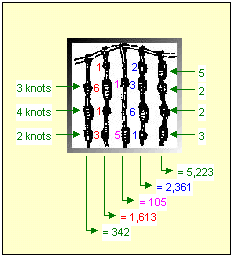 The combination
of fiber types, dye colors, and intricate knotting could be a
novel form of written language, according to Harvard
anthropologist Gary Urton. He claims that the quipus contain a
seven-bit binary code capable of conveying more than 1,500
separate units of information. The combination
of fiber types, dye colors, and intricate knotting could be a
novel form of written language, according to Harvard
anthropologist Gary Urton. He claims that the quipus contain a
seven-bit binary code capable of conveying more than 1,500
separate units of information.
Quipus were knotted ropes using a
positional decimal system. A knot in a row farthest from the
main strand represented one, next farthest ten, etc. The absence
of knots on a cord implied zero.
Quipucamayocs, the
accountants of the Inca Empire (called Tahuantinsuyu in old
spelling Quechua) created and deciphered the quipu knots.
Quipucamayocs were capable of performing simple mathematical
calculations such as adding, subtracting, multiplying, and
dividing information for the indigenous people.
In the absence of written records
the quipus served as a means of recording history and passed on
to the next generation, which used them as reminders of stories.
An thus these primitive computers - quipus - had knotted in
their memory banks the information which tied together the Inca
empire.
Hiram Bingham, the American explorer who
found the ruins of Machu Picchu in 1911, wrote:
"The
Incas had never acquired the art of writing, but they had
developed an elaborate system of knotted cords called quipus.
These were made of the wool of the alpaca or the llama, dyed in
various colors, the significance of which was known to the
magistrates. The cords were knotted in such a way to represent
the decimal system and were fastened at close intervals along
the principal strand of the quipus. Thus an important message
relating to the progress of crops, the amount of taxes
collected, or the advance of an enemy could be speedily sent by
the trained runners along the post roads."
�Lost City of the Incas, The Story
of Machu Picchu and its Builders� by Hiram Bingham.
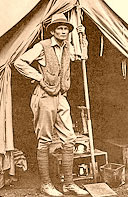
Hiram Bingham at Machu Picchu, 1911
The inspiration for Indiana Jones?
|
|
|
The Quipus
and The Royal Commentaries of the Inca
In 1609, the Inca Garcilaso de la Vega published the
first volume of his Royal Commentaries of the Incas in
Lisbon. He wrote:
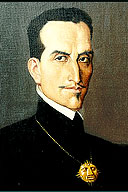 The
word quipu means both knot or to knot; it
was also used for accounts, because they were kept by
means of the knots tied in a number of cords of
different thicknesses and colors, each one of which had
a special significance. Thus, gold was represented by a
gold cord, silver by a white one, and fighting men by a
red cord. The
word quipu means both knot or to knot; it
was also used for accounts, because they were kept by
means of the knots tied in a number of cords of
different thicknesses and colors, each one of which had
a special significance. Thus, gold was represented by a
gold cord, silver by a white one, and fighting men by a
red cord.
When their
accounts had to do with things that have no color - such
as grain and vegetables - they were classified by
categories, and, in each category, by order of
diminishing size. Thus, to furnish an example, if they
had had to count the various types of agricultural
production in Spain, they would have started with
wheat, then rye, then peas, then beans, and so forth. In
the same way, in order to make an inventory of the arms
of the imperial army, they first counted the arms that
were considered to belong in a superior category, such
as lances, then javelins, bows and arrows, hatchets and
maces, and lastly, slings, an any other arms that were
used. In order to ascertain the number of vassals in the
Empire, they started with each village, then with each
province: the firs cord showed a census of men over
sixty, the second, those between fifty and sixty, the
third, those from forty to fifty, and so on, by decades,
down to the babes at the breast.
Occasionally
other, thinner, cords of the same color, could be seen
among one of these series, as though they represented an
exception to the rule; thus, for instance, among the
figures that concerned the men of such and such an age,
all of whom were considered to be married, the thinner
cords indicated the number of widowers of the same age,
for the year in question: because, as I explained
before, population figures, together with those of all
the other resources of the Empire, were brought up to
date every year.
According to
their position, the knots signified units, tens,
hundreds, thousands, ten thousands and, exceptionally,
hundred thousands, and they were all as well aligned on
their different cords as the figures that an accountant
sets down, column by column, in his ledger. Indeed,
those men, called quipucamayus, who were in
charge of the quipus, were exactly that, imperial
accountants.
The number
of quipucamayus scattered throughout the Empire, was
proportional to the size of each place. Thus the
smallest villages numbered four, and others twenty, or
even thirty. The Incas preferred this arrangement. even
in places where one accountant would have sufficed, the
idea being that, if several of them kept the same
accounts, there was less risk that they would make
mistakes.
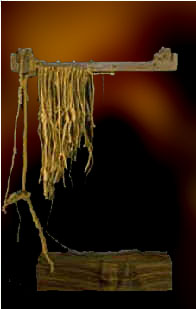 Every
year, an inventory of all the Inca's possessions was
made. Nor was there a single birth or death, a single
departure or return of a soldier, in all the Empire,
that was not noted on the quipus. And indeed, it may be
said that everything that could be counted, was counted
in this way, even to battles, diplomatic missions, and
royal speeches. But since it was only possible to record
numbers in this manner, and not words, the quipucamayus
assigned to record ambassadorial missions and speeches,
learned them by heart, at the same time that they noted
down the numbers, places and dates on their quipus; and
thus, from father to son, they transmitted this
information to their successors. The speeches exchanged
between the Incas and their vassals on important
occasions, such as the surrender of a new province, were
also transmitted to posterity by the amautas, or
philosophers, who summarized them in simple, clear
fables, in order that they might be implanted by word of
mouth in the memories of all the people from those at
court to the inhabitants of the most remote hamlets. The
harauicus, or poets, also composed poems based on
diplomatic records and royal speeches. These poems were
recited for a great victory or festival, and every time
a new Inca was knighted. Every
year, an inventory of all the Inca's possessions was
made. Nor was there a single birth or death, a single
departure or return of a soldier, in all the Empire,
that was not noted on the quipus. And indeed, it may be
said that everything that could be counted, was counted
in this way, even to battles, diplomatic missions, and
royal speeches. But since it was only possible to record
numbers in this manner, and not words, the quipucamayus
assigned to record ambassadorial missions and speeches,
learned them by heart, at the same time that they noted
down the numbers, places and dates on their quipus; and
thus, from father to son, they transmitted this
information to their successors. The speeches exchanged
between the Incas and their vassals on important
occasions, such as the surrender of a new province, were
also transmitted to posterity by the amautas, or
philosophers, who summarized them in simple, clear
fables, in order that they might be implanted by word of
mouth in the memories of all the people from those at
court to the inhabitants of the most remote hamlets. The
harauicus, or poets, also composed poems based on
diplomatic records and royal speeches. These poems were
recited for a great victory or festival, and every time
a new Inca was knighted.
When the
curacas and dignitaries of a province want to know some
historical detail concerning their predecessors, they
asked these quipucamayus, who were, in other words, not
only the accountants, but also the historians of each
nation. The result was that the quipucamayus never let
their quipus out of their hands, and they kept passing
their cords and knots through their fingers so as not to
forget the tradition behind all these accounts. In fact,
their responsibility was so great and so absorbing, that
they were exempted from all tribute as well as from all
other kinds of service.
All laws,
ordinances, rites, and ceremonies throughout the Empire
were recorded by these same means.
When my
father's Indians came to town on Midsummer's Day to pay
their tribute, they brought me the quipus; and the
curacas asked my mother to take note of their stories,
for they mistrusted the Spaniards, and feared that they
would not understand them. I was able to reassure them
by re-reading what I had noted down under their
dictation, and they used to follow my reading, holding
on to their quipus, to be certain of my exactness; this
was how I succeeded in learning many things quite as
perfectly as did the Indians. |
|
|
|
|
|
|
Illustrations from 1615 by
The "Indian Chronicler" Felipe Guaman
Poma de Ayala about the quipu.
Finding his most persuasive medium to be the visual image,
he organizes his 1200-page Nueva cor�nica y buen gobierno
(New Chronicle and Good Government) around his 398
pen-and-ink drawings, all skillfully executed by his own hand.
For the archaeologist, Guaman Poma's drawings of native life
under the Incas are like photographs of the past.
| |
|
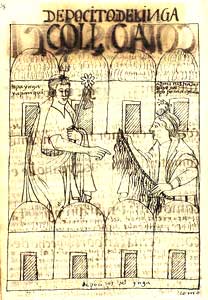
An encounter
at a "Collca" or "Warehouse of the Inca": Tupac Inca
Yupanqui (left) interviews his accountant or
warehousekeeper (right). The warehousekeeper is
extending a cord record or quipu, which contains
records of goods in the storage chambers. |
|
|
|
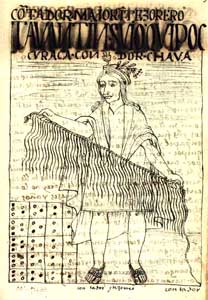
Chief
accountant and treasurer, authority in charge of the quipu
of the kingdom.
In the lower left corner, there is an abacus counting
device used with maize kernels on which computations
were performed and later transferred to the quipu.
The maize
kernels are the first numbers of the Fibonacci series,
in which each number is a sum of two previous: 1, 2, 3,
5. |
|
|
| |
|
|
|
|
|
|
|
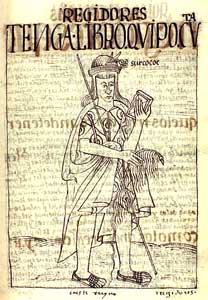
The native
administrator of resources, with the book and quipu he uses for
accounting. |
|
|
|
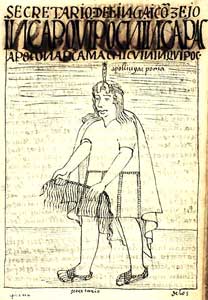
The Inka�s
secretary and accountant who records the dispositions of the
royal lords. |
|
|
Reference:
Guaman Poma - 'El primer Nueva cor�nica y buen gobierno'.
|
|
|
|
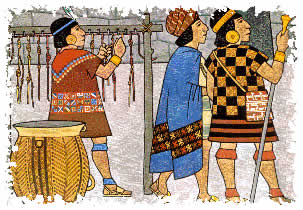
Caral: Ancient Peru city reveals 5,000-year-old
'writing'
July 19, 2005, 22:45,
SABC News
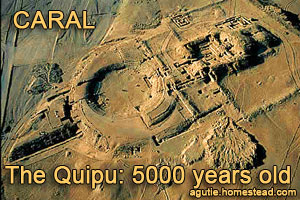 Archeologists
in Peru have found a "quipu" on the site of the oldest
city in the Americas, indicating the device, a
sophisticated arrangement of knots and strings used to
convey detailed information, was in use thousands of
years earlier than previously believed. Previously the
oldest known quipus, often associated with the Incas
whose vast South American empire was conquered by the
Spanish in the 16th century, dated from about 650 AD. Archeologists
in Peru have found a "quipu" on the site of the oldest
city in the Americas, indicating the device, a
sophisticated arrangement of knots and strings used to
convey detailed information, was in use thousands of
years earlier than previously believed. Previously the
oldest known quipus, often associated with the Incas
whose vast South American empire was conquered by the
Spanish in the 16th century, dated from about 650 AD.
But Ruth Shady, an archeologist leading investigations
into the Peruvian coastal city of Caral, said quipus
were among a treasure trove of articles discovered at
the site, which are about 5,000 years old. "This is the
oldest quipu and it shows us that this society ... also
had a system of "writing" (which) would continue down
the ages until the Inca empire and would last some 4,500
years," Shady said. She was speaking before the opening
in Lima today of an exhibition of the artifacts which
shed light on Caral, which she called one of the world's
oldest civilizations.
The quipu with its well-preserved, brown cotton strings
wound around thin sticks, was found with a series of
offerings including mysterious fiber balls of different
sizes wrapped in "nets" and pristine reed baskets. "We
are sure it corresponds to the period of Caral because
it was found in a public building," Shady said. "It was
an offering placed on a stairway when they decided to
bury this and put down a floor to build another
structure on top."
Pyramid-shaped public buildings were being built at
Caral, a planned coastal city 180km north of Lima, at
the same time that the Saqqara pyramid, the oldest in
Egypt, was going up. They were already being
revamped when Egypt's Great Pyramid of Keops (or Khufu)
was under construction, Shady said. "Man only began
living in an organized way 5,000 years ago in five
points of the globe - Mesopotamia (roughly comprising
modern Iraq and part of Syria), Egypt, India, China and
Peru," Shady said, adding Caral was 3,200 years older
than cities of another ancient American civilization,
the Maya.
|
|
|
|
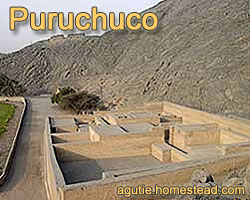 Knotty
Incan Accounting Untangled
Knotty
Incan Accounting Untangled
Source: Science News, August
12, 2005
A ball of string tied
into countless knots could very well be seen as a source
of frustration. But for the ancient Inca civilization,
carefully tied knots formed the basis of a method of
record-keeping known as khipus. Now researchers report
that the ledger system is more complex than previously
believed and includes a way of communicating information
to higher-ups in the well-categorized Incan chain of
command between workers and administrators with higher
rank.
Hundreds of khipus, each consisting of a single strand
of wool from which hundreds to thousands of other
knotted strings hang, have been discovered to date. Gary
Upton and Carrie J. Brezine of Harvard University
designed a computer program to analyze the patterns in
21 khipus recovered from a site in Puruchuco, an Inca
administrative center on the coast of Peru near modern
day Lima. They discovered that certain patterns within
the strings of varying colors and lengths appear to
contain numerical data that represent summations. What
is more, the information is arranged among the khipus in
a ranked pattern with three levels of authority.
Information is passed between them by including the sum
from a khipu in one level on a khipu representing a
higher level.
|
|
|
|
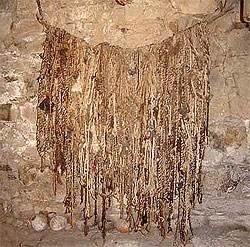 Quipus of Rapaz Quipus of Rapaz
Left, A
collection of Quipus in San Cristobal de Rapaz, Oyon,
Lima-Peru.
A project of research and
conservation began in January 2004 with an agreement
between the village and the anthropologist Frank
Salomon, of the University of Wisconsin in the USA. The
village agreed to give access for scientific study in
exchange for conservation help to make the quipus and
their environment safer against deterioration.
Source:
The Khipu Patrimony of Rapaz, Peru |
|
|
|
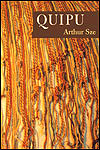 Quipu
as a central metaphor
Quipu
as a central metaphor
In Quipu, Arthur Sze�s
eighth book of poetry, he writes with imaginative rigor
and urgency poems that move across cultures and time,
from elegy to ode, to find a precarious splendor.
Source: Quipu by Arthur Sze
Quipu was a tactile
recording device for the pre-literate Inca, an
assemblage of colored knots on cords. Sze utilizes quipu
as a central metaphor, knotting and stringing luminous
poems that each have an essential place and integrity,
each contribute to the recurrent �knotting� in the book.
Sze�s language is taut and startling, and what appears
stable may actually be volatile. In Quipu Sze harnesses
the particulars of our lives and spins them into
something enduring. He makes us envision the terrors and
marvels of our contemporary world in this collection of
crucial poems of our time.
What is �Quipu?�
Quipu means knot in Quechua, the native language of the
Andes. The Incas had a system of accounting and data
recording that relied on the quipu, a devise in which
cords of various colors were attached to a main cord
with knots. The number and position of knots as well as
the color of each cord represented information about
commercial goods and resources. Quipu-makers were
responsible for encoding and decoding the information.
The messages included information about resources in
storehouses, taxes, census information, the output of
mines, or the composition of work forces. Archeologists
have recently suggested that authors used the quipu to
compose and preserve poems and legends. Because there
were relatively few words in Quechua, the cords of a
quipu could be used as pronunciation keys.
In "The Angle of Reflection
Equals the Angle of Incidence," he writes:
Quinoa simmers in a pot;
the aroma of cilantro
on swordfish; the cusp of spring when you
lean your head on my shoulder. Orange crocuses
in the backyard form a line. Once is a scorched
site;
we stoop in the grass, finger twelve keys with
interconnected rings on a swiveling yin-yang coin,
dangle them from the gate, but no one claims them.
|
|
|
|
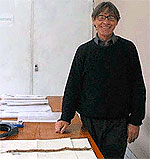 Conversations:
String Theorist Conversations:
String Theorist
Unraveling a knotty Inca
puzzle
Source: Archaeology, A
publication of the Archaeological Institute of America,
Volume 58 Number 6, November/December 2005 .
Khipu, the enigmatic and
still undeciphered record-keeping system of elaborately
knotted strings used by the Inca Empire, has long
intrigued anthropologist Gary Urton. Since 2002, he and
his colleague Carrie Brezine, a mathematician, have
maintained the Khipu Database Project at Harvard
University, which corrals all existing khipu scholarship
in one online repository. Most recently, they announced
they may have found the meaning of a particular sequence
of knots. ARCHAEOLOGY spoke with Gary Urton about
mystified Spanish colonials, teaching Harvard students
how to make khipu, and bringing tax records to the
afterlife.
See more.
|
|
|
|
|
|
|